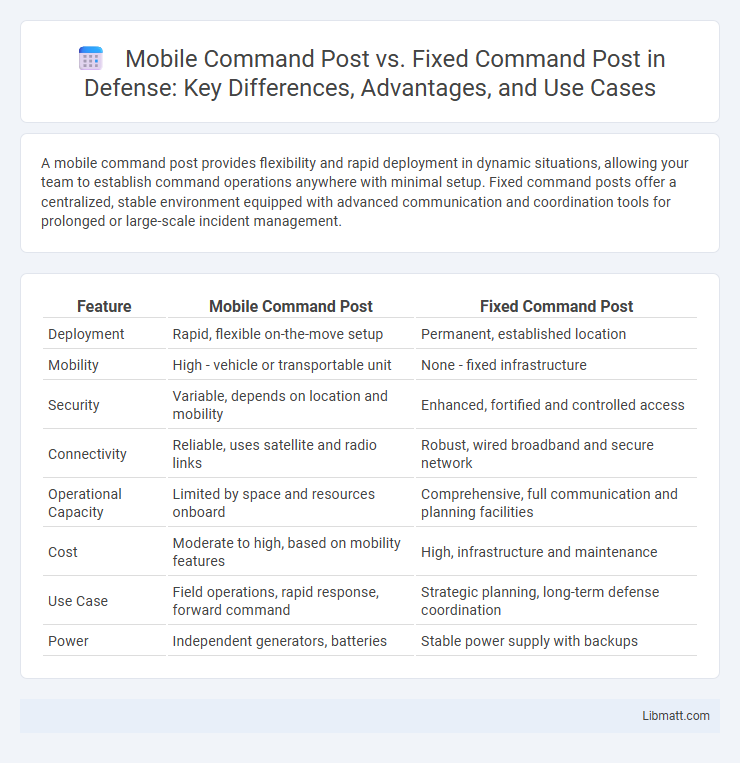A mobile command post provides flexibility and rapid deployment in dynamic situations, allowing your team to establish command operations anywhere with minimal setup. Fixed command posts offer a centralized, stable environment equipped with advanced communication and coordination tools for prolonged or large-scale incident management.
Table of Comparison
| Feature | Mobile Command Post | Fixed Command Post |
|---|---|---|
| Deployment | Rapid, flexible on-the-move setup | Permanent, established location |
| Mobility | High - vehicle or transportable unit | None - fixed infrastructure |
| Security | Variable, depends on location and mobility | Enhanced, fortified and controlled access |
| Connectivity | Reliable, uses satellite and radio links | Robust, wired broadband and secure network |
| Operational Capacity | Limited by space and resources onboard | Comprehensive, full communication and planning facilities |
| Cost | Moderate to high, based on mobility features | High, infrastructure and maintenance |
| Use Case | Field operations, rapid response, forward command | Strategic planning, long-term defense coordination |
| Power | Independent generators, batteries | Stable power supply with backups |
Introduction to Command Posts
Command posts serve as critical hubs for coordinating operations during emergencies or large-scale events. Mobile command posts provide flexibility and rapid deployment capabilities, enabling commanders to direct activities directly from the field. Fixed command posts offer a stable, technology-rich environment optimized for prolonged, centralized control and communication.
Defining Mobile Command Posts
Mobile command posts are specialized vehicles equipped with advanced communication systems, allowing first responders to coordinate emergency operations directly at the incident site. Unlike fixed command posts, which are stationary facilities with permanent infrastructure, mobile command posts provide flexibility and rapid deployment for on-scene management. Your emergency response team benefits from enhanced situational awareness and real-time decision-making through these mobile units.
Defining Fixed Command Posts
Fixed command posts are stationary operational centers established at a permanent location, often equipped with advanced communication and surveillance technologies to manage emergency response or military operations effectively. These posts provide a secure environment for coordination, data analysis, and decision-making, ensuring uninterrupted connectivity through robust infrastructure. Unlike mobile command posts, fixed command posts offer enhanced stability, extensive resource availability, and a controlled setting designed for prolonged missions and strategic planning.
Key Differences: Mobility vs Stability
A mobile command post offers unparalleled flexibility and rapid deployment, ideal for dynamic situations requiring swift relocation and adaptable communication setups. In contrast, a fixed command post provides enhanced stability, robust infrastructure, and continuous power supply, ensuring reliable long-term operations in a single location. Your choice depends on mission requirements, with mobile units prioritizing mobility for field responsiveness and fixed units emphasizing stability for sustained command functions.
Operational Flexibility and Deployment
Mobile command posts provide superior operational flexibility by enabling rapid deployment and repositioning in dynamic environments, allowing command teams to maintain situational awareness closer to the field. Fixed command posts offer a stable, fortified environment with robust communication infrastructure but lack the mobility needed for quick response during evolving incidents. Prioritizing mission requirements, mobile units excel in tactical versatility, while fixed posts support comprehensive strategic coordination with established resources.
Communication Infrastructure and Technology
Mobile command posts employ advanced, portable communication infrastructures such as satellite links, cellular networks, and radio systems to ensure seamless connectivity in dynamic or remote environments. Fixed command posts benefit from stable, high-capacity wired networks with integrated VoIP systems, robust broadband access, and dedicated data centers for uninterrupted operations. Both utilize state-of-the-art technologies, but mobile units emphasize flexibility and rapid deployment, while fixed units prioritize bandwidth and system redundancy for sustained command functions.
Resource and Personnel Requirements
Mobile command posts require fewer fixed infrastructure resources but demand skilled personnel trained in rapid deployment and multi-task coordination under variable conditions. Fixed command posts necessitate extensive physical infrastructure, including robust communication systems and dedicated power supplies, alongside personnel specializing in long-term operational management. Resource allocation for mobile units prioritizes flexibility and mobility, while fixed posts emphasize stability and sustained support capabilities.
Security and Vulnerability Considerations
Mobile command posts offer enhanced security through their ability to relocate, reducing vulnerability to targeted attacks and surveillance. Fixed command posts, while often equipped with robust physical security measures such as reinforced structures and controlled access points, face increased risks from prolonged exposure and fixed geographic positioning. Effective security strategies must balance the mobility benefits of rapid repositioning with the stability and infrastructure advantages of fixed installations.
Use Cases: When to Choose Each Command Post
Mobile command posts excel in disaster response, emergency management, and events requiring rapid deployment and on-site coordination, offering flexibility and real-time communication in dynamic environments. Fixed command posts are ideal for long-term operations, large facilities, or metropolitan centers, providing robust infrastructure, enhanced security, and stable connectivity for continuous monitoring and strategic planning. Evaluate Your operational needs, geographic factors, and response time to determine whether a mobile or fixed command post best supports your mission objectives.
Future Trends in Command Post Development
Future trends in command post development emphasize enhanced mobility and real-time data integration, with mobile command posts increasingly equipped with advanced communication technologies and AI-driven analytics. Fixed command posts continue to evolve with fortified cyber defenses and scalable infrastructure to support complex operations. Your operational efficiency benefits from hybrid frameworks combining the agility of mobile units with the robust capabilities of fixed facilities.
Mobile command post vs Fixed command post Infographic

 libmatt.com
libmatt.com